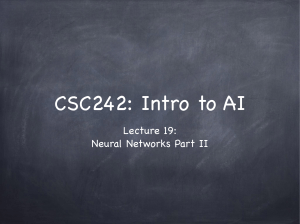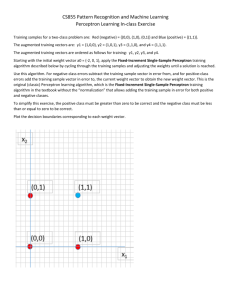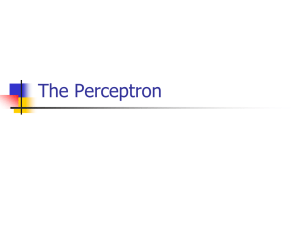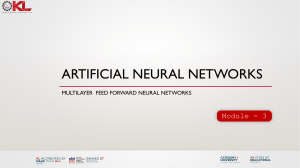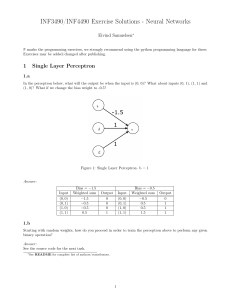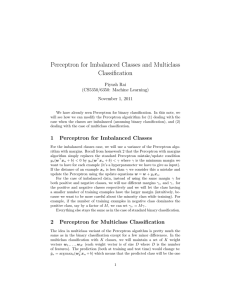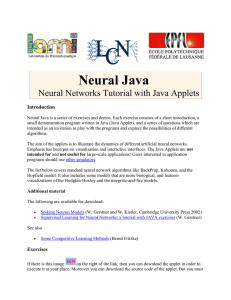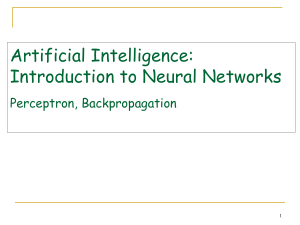VII. Neural Networks and Learning 11/24/03 1
advertisement
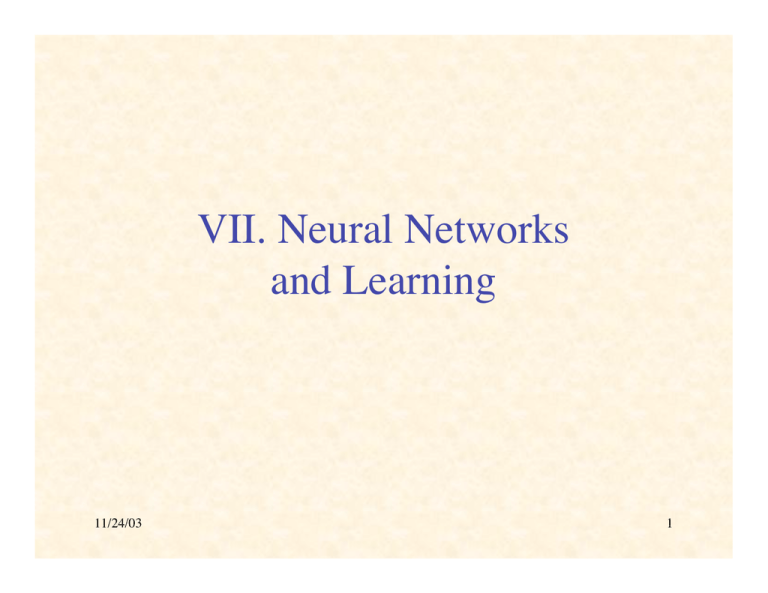
VII. Neural Networks
and Learning
11/24/03
1
Supervised Learning
• Produce desired outputs for training inputs
• Generalize reasonably & appropriately to
other inputs
• Good example: pattern recognition
• Feedforward multilayer networks
11/24/03
2
input
layer
11/24/03
hidden
layers
...
...
...
...
...
...
Feedforward Network
output
layer
3
Typical Artificial Neuron
connection
weights
inputs
output
threshold
11/24/03
4
Typical Artificial Neuron
linear
combination
activation
function
net input
(local field)
11/24/03
5
Equations
n
hi = ∑ w ij s j − θ
j=1
h = Ws − θ
Net input:
Neuron output:
€
11/24/03
s′i = σ ( hi )
s′ = σ (h)
6
11/24/03
...
...
Single-Layer Perceptron
7
Variables
x1
w1
xj
Σ
wj
h
Θ
y
wn
xn
11/24/03
θ
8
Single Layer Perceptron
Equations
Binary threshold activation function :
1, if h > 0
σ ( h ) = Θ( h ) =
0, if h ≤ 0
1, if ∑ w x > θ
j j
j
Hence, y =
0, otherwise
€
1, if w ⋅ x > θ
=
0, if w ⋅ x ≤ θ
11/24/03
€
9
€
2D Weight Vector
w2
w ⋅ x = w x cos φ
v
cos φ =
x
+
w
w⋅ x = w v
φ
€
€
€
x
–
w⋅ x > θ
⇔ w v >θ
⇔v >θ w
11/24/03
v
w1
θ
w
10
N-Dimensional Weight Vector
+
w
normal
vector
separating
hyperplane
–
11/24/03
11
Goal of Perceptron Learning
• Suppose we have training patterns x1, x2,
…, xP with corresponding desired outputs
y1, y2, …, yP
• where xp ∈ {0, 1}n, yp ∈ {0, 1}
• We want to find w, θ such that
yp = Θ(w⋅xp – θ) for p = 1, …, P
11/24/03
12
Treating Threshold as Weight
n
h = ∑ w j x j − θ
j=1
x1
n
= −θ + ∑ w j x j
w1
xj
j=1
Σ
wj
wn
xn
11/24/03
h
Θ
y
€
θ
13
Treating Threshold as Weight
n
h = ∑ w j x j − θ
j=1
x0 = –1
x1
n
w1
xj
wn
xn
j=1
Σ
wj
= −θ + ∑ w j x j
θ = w0
h
Θ
y
€
Let x 0 = −1 and w 0 = θ
n
n
˜ ⋅ x˜
h = w 0 x 0 + ∑ w j x j =∑ w j x j = w
j=1
11/24/03
€
j= 0
14
Augmented Vectors
θ
w1
˜ =
w
M
wn
−1
p
x
1
p
x˜ =
M
p
xn
˜ ⋅ x˜ p ), p = 1,K,P
We want y p = Θ( w
€
11/24/03
€
15
Reformulation as Positive
Examples
We have positive (y p = 1) and negative (y p = 0) examples
˜ ⋅ x˜ p > 0 for positive, w
˜ ⋅ x˜ p ≤ 0 for negative
Want w
€
€
€
€
Let z p = x˜ p for positive, z p = −x˜ p for negative
˜ ⋅ z p ≥ 0, for p = 1,K,P
Want w
Hyperplane through origin with all z p on one side
11/24/03
16
Adjustment of Weight Vector
z5
z1
z9
z10 11
z
z6
z2
z3
z8
z4
z7
11/24/03
17
Outline of
Perceptron Learning Algorithm
1. initialize weight vector randomly
2. until all patterns classified correctly, do:
a) for p = 1, …, P do:
1) if zp classified correctly, do nothing
2) else adjust weight vector to be closer to correct
classification
11/24/03
18
Weight Adjustment
p
η
z
˜ ′′
p
w
ηz
z
˜′
w
p
˜
w
€ €
€
€
€
€
11/24/03
19
Improvement in Performance
p
˜ ⋅ z < 0,
If w
˜ ′ ⋅ z = (w
˜ + ηz ) ⋅ z
w
p
p
p
p
p
p
˜
= w ⋅ z + ηz ⋅ z
€
p
˜ ⋅ z +η z
=w
p 2
p
˜
> w⋅ z
11/24/03
€
20
Perceptron Learning Theorem
• If there is a set of weights that will solve the
problem,
• then the PLA will eventually find it
• (for a sufficiently small learning rate)
• Note: only applies if positive & negative
examples are linearly separable
11/24/03
21
Classification Power of
Multilayer Perceptrons
• Perceptrons can function as logic gates
• Therefore MLP can form intersections,
unions, differences of linearly-separable
regions
• Classes can be arbitrary hyperpolyhedra
• Minsky & Papert criticism of perceptrons
• No one succeeded in developing a MLP
learning algorithm
11/24/03
22
Credit Assignment Problem
input
layer
11/24/03
hidden
layers
...
...
...
...
...
...
How do we adjust the weights of the hidden layers?
output
layer
23
